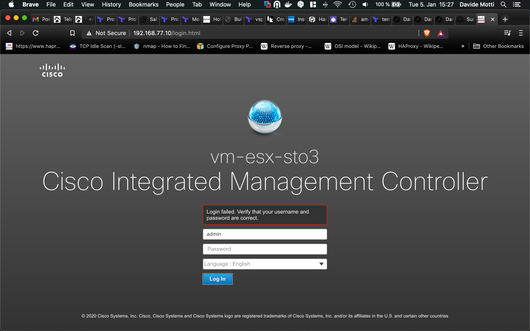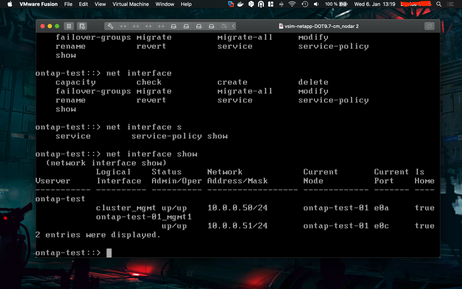Simulator Discussions
- Home
- :
- Developer Network
- :
- Simulator Discussions
- :
- Re: ONTAP 9 Simulator: cannot access the GUI
Simulator Discussions
- Subscribe to RSS Feed
- Mark Topic as New
- Mark Topic as Read
- Float this Topic for Current User
- Bookmark
- Subscribe
- Mute
- Printer Friendly Page
- Mark as New
- Bookmark
- Subscribe
- Mute
- Subscribe to RSS Feed
- Permalink
- Report Inappropriate Content
- Mark as New
- Bookmark
- Subscribe
- Mute
- Subscribe to RSS Feed
- Permalink
- Report Inappropriate Content
Did you see the note on page 16:
NOTE: Be aware this guide mixes examples of the VMnet8 on different subnets (192.168.23.0 above, 17.0 later on, etc)
Are you using IP space suitable to your environment? The screenshot you provided isn't much help, at the same prompt can you please type "net int show" and provide the output of that?
- Mark as New
- Bookmark
- Subscribe
- Mute
- Subscribe to RSS Feed
- Permalink
- Report Inappropriate Content
Hi, thank you for your answer but sorry what is the relationship between ip environment and not being able to log in to the GUI?
I don't think the network configuration has anything to do with the problem described above: I can access the GUI in the Browser without any problems, the problem is that I can't log in either with the default user or with other users that I have created after logging in from the CLI.
- Mark as New
- Bookmark
- Subscribe
- Mute
- Subscribe to RSS Feed
- Permalink
- Report Inappropriate Content
Sorry for misunderstanding, but you literally started your original post with "cannot access the GUI".
Looking at your screenshot, that's a Cisco web page, not the ONTAP Cluster login. Please provide the previously requested output, or find out what IP the cluster_mgmt LIF is on, and try that instead.
- Mark as New
- Bookmark
- Subscribe
- Mute
- Subscribe to RSS Feed
- Permalink
- Report Inappropriate Content
Hi, thank you for the answer.
The Gui that I try to reach is the GUI that ONTAP Install suggest to open in order to complete the setup (http://192.168.77.10).
The network configuration is setup as described on ONTAP-Sim-Getting_Started_Quick:
IP from vmnet8: 192.168.77.10
Netmask: 255.255.255.0
Gateway: 192.168.77.2
But with username: admin and pwd: netapp!123 as in your guide described it says that the credentials are not correct:
However with this credentials I am able to log into the CLI:

And this ist the output of the command that you requested:
P.S. I started my post with "cannot access the GUI" because this is my problem, I cannot access/log into the GUI. Over the CLI I can create users, cluster and so on, but I am not able to log into the GUI.
Thanks in advance.
- Mark as New
- Bookmark
- Subscribe
- Mute
- Subscribe to RSS Feed
- Permalink
- Report Inappropriate Content
The IP space you're using is conflicting with existing IP allocation in your environment as the GUI presented is for the out of band management interface of some Cisco server. Also, I see .11, the cluster_mgmt LIF is hosted on e0a whereas .10, node_mgmt is on e0c. Typically under Fusion, both e0a and e0b are used for ClusterNet and the Fusion setting would be "host-only" and e0c/e0d are used for client access and by default set to "NAT" in Fusion. The CLI you're logging into is effectively the serial port of the simulator so IP addresses don't come into play. You likely can't ssh to either IP either because they're probably both assigned to external servers. I'd recommend changing IP spaces completely, try moving to 10.0.0.0/24. In the console, type:
net int modify -vserver ontap-test -lif cluster_mgmt -address 10.0.0.50 -netmask 255.255.255.0
net int modify -vserver ontap-test -lif ontap-test-01_mgmt1 -address 10.0.0.51 -netmask 255.255.255.0
Then in Fusion, make sure e0a/e0b is set to host-only and e0c/e0d is set to NAT, I use Bridged here so that I can access the simulator from other hosts as well, not just my laptop. Try connecting via https to either of the new IP addresses as well as ssh. I'm not sure why your cluster_mgmt is on e0a, but I assume it's because you set it to a single-node cluster, I don't do this specifically because I want the ClusterNet interfaces to still exist for better screenshots. Then you should be able to hit https://10.0.0.50/ and login.
- Mark as New
- Bookmark
- Subscribe
- Mute
- Subscribe to RSS Feed
- Permalink
- Report Inappropriate Content
Thank you for the instructions, but with this settings when I call https://10.0.0.50 in my browser no service/GUI is reachable.
It is not clear to me why should I use 10.0.0.0/24 space. As described on the official Docs it should be this provided by the vmnet8 adapter:
And the through the cluster management Ip it should be possible connect via ssh or https:
This is how the network configuration looks like (the Fusion settings are as you described):
- Mark as New
- Bookmark
- Subscribe
- Mute
- Subscribe to RSS Feed
- Permalink
- Report Inappropriate Content
Can you also provide the output of "ifconfig -a" from your Mac please?
- Mark as New
- Bookmark
- Subscribe
- Mute
- Subscribe to RSS Feed
- Permalink
- Report Inappropriate Content
Also, what happens when you try to ping those two addresses?
- Mark as New
- Bookmark
- Subscribe
- Mute
- Subscribe to RSS Feed
- Permalink
- Report Inappropriate Content
Not pingable (Request Timeout).
- Mark as New
- Bookmark
- Subscribe
- Mute
- Subscribe to RSS Feed
- Permalink
- Report Inappropriate Content
Hi there, I wrote this post for you. I believe by your username that you're in Germany and the time difference makes troubleshooting onerous. Also, I will be unavailable for a few days now. Kindly let me know if it helps.
- Mark as New
- Bookmark
- Subscribe
- Mute
- Subscribe to RSS Feed
- Permalink
- Report Inappropriate Content
16:13 $ ifconfig -a
lo0: flags=8049<UP,LOOPBACK,RUNNING,MULTICAST> mtu 16384
options=1203<RXCSUM,TXCSUM,TXSTATUS,SW_TIMESTAMP>
inet 127.0.0.1 netmask 0xff000000
inet6 ::1 prefixlen 128
inet6 fe80::1%lo0 prefixlen 64 scopeid 0x1
nd6 options=201<PERFORMNUD,DAD>
gif0: flags=8010<POINTOPOINT,MULTICAST> mtu 1280
stf0: flags=0<> mtu 1280
en0: flags=8863<UP,BROADCAST,SMART,RUNNING,SIMPLEX,MULTICAST> mtu 1500
options=400<CHANNEL_IO>
ether 98:01:a7:9f:cc:99
inet6 fe80::10b6:497f:e456:1546%en0 prefixlen 64 secured scopeid 0x5
inet 192.168.178.61 netmask 0xffffff00 broadcast 192.168.178.255
inet6 2001:16b8:42b1:f400:c2f:a6a9:3949:e9a0 prefixlen 64 autoconf secured
inet6 2001:16b8:42b1:f400:f851:e664:21e7:8d6b prefixlen 64 autoconf temporary
nd6 options=201<PERFORMNUD,DAD>
media: autoselect
status: active
en1: flags=8963<UP,BROADCAST,SMART,RUNNING,PROMISC,SIMPLEX,MULTICAST> mtu 1500
options=460<TSO4,TSO6,CHANNEL_IO>
ether 82:13:19:88:46:40
media: autoselect <full-duplex>
status: inactive
en2: flags=8963<UP,BROADCAST,SMART,RUNNING,PROMISC,SIMPLEX,MULTICAST> mtu 1500
options=460<TSO4,TSO6,CHANNEL_IO>
ether 82:13:19:88:46:41
media: autoselect <full-duplex>
status: inactive
bridge0: flags=8863<UP,BROADCAST,SMART,RUNNING,SIMPLEX,MULTICAST> mtu 1500
options=63<RXCSUM,TXCSUM,TSO4,TSO6>
ether 82:13:19:88:46:40
Configuration:
id 0:0:0:0:0:0 priority 0 hellotime 0 fwddelay 0
maxage 0 holdcnt 0 proto stp maxaddr 100 timeout 1200
root id 0:0:0:0:0:0 priority 0 ifcost 0 port 0
ipfilter disabled flags 0x0
member: en1 flags=3<LEARNING,DISCOVER>
ifmaxaddr 0 port 6 priority 0 path cost 0
member: en2 flags=3<LEARNING,DISCOVER>
ifmaxaddr 0 port 7 priority 0 path cost 0
nd6 options=201<PERFORMNUD,DAD>
media: <unknown type>
status: inactive
p2p0: flags=8843<UP,BROADCAST,RUNNING,SIMPLEX,MULTICAST> mtu 2304
options=400<CHANNEL_IO>
ether 0a:01:a7:9f:cc:99
media: autoselect
status: inactive
awdl0: flags=8943<UP,BROADCAST,RUNNING,PROMISC,SIMPLEX,MULTICAST> mtu 1484
options=400<CHANNEL_IO>
ether d6:e8:f5:58:3d:25
inet6 fe80::d4e8:f5ff:fe58:3d25%awdl0 prefixlen 64 scopeid 0xa
nd6 options=201<PERFORMNUD,DAD>
media: autoselect
status: active
llw0: flags=8863<UP,BROADCAST,SMART,RUNNING,SIMPLEX,MULTICAST> mtu 1500
options=400<CHANNEL_IO>
ether d6:e8:f5:58:3d:25
inet6 fe80::d4e8:f5ff:fe58:3d25%llw0 prefixlen 64 scopeid 0xb
nd6 options=201<PERFORMNUD,DAD>
media: autoselect
status: active
utun0: flags=8051<UP,POINTOPOINT,RUNNING,MULTICAST> mtu 1380
inet6 fe80::518:50b2:6425:1334%utun0 prefixlen 64 scopeid 0xc
nd6 options=201<PERFORMNUD,DAD>
utun1: flags=8051<UP,POINTOPOINT,RUNNING,MULTICAST> mtu 2000
inet6 fe80::21b3:6267:6ebd:778a%utun1 prefixlen 64 scopeid 0xd
nd6 options=201<PERFORMNUD,DAD>
en4: flags=8963<UP,BROADCAST,SMART,RUNNING,PROMISC,SIMPLEX,MULTICAST> mtu 1500
options=50b<RXCSUM,TXCSUM,VLAN_HWTAGGING,AV,CHANNEL_IO>
ether 68:5b:35:cb:3a:f4
inet6 fe80::8d3:b2d4:2c47:b4a0%en4 prefixlen 64 secured scopeid 0x4
inet 192.168.178.72 netmask 0xffffff00 broadcast 192.168.178.255
inet6 2001:16b8:42b1:f400:1c0a:23b0:41c5:5eb0 prefixlen 64 autoconf secured
inet6 2001:16b8:42b1:f400:513f:f3ed:2dd1:819a prefixlen 64 autoconf temporary
nd6 options=201<PERFORMNUD,DAD>
media: autoselect (1000baseT <full-duplex,energy-efficient-ethernet>)
status: active
tap0: flags=8843<UP,BROADCAST,RUNNING,SIMPLEX,MULTICAST> mtu 1500
ether ba:05:bd:63:fc:8b
inet 172.20.2.6 netmask 0xffffff00 broadcast 172.20.2.255
media: autoselect
status: active
open (pid 5268)
utun2: flags=8051<UP,POINTOPOINT,RUNNING,MULTICAST> mtu 1380
inet6 fe80::99b2:2463:2462:8b79%utun2 prefixlen 64 scopeid 0x11
nd6 options=201<PERFORMNUD,DAD>
utun3: flags=8051<UP,POINTOPOINT,RUNNING,MULTICAST> mtu 1380
inet6 fe80::4556:1143:a218:ad04%utun3 prefixlen 64 scopeid 0x12
nd6 options=201<PERFORMNUD,DAD>
vboxnet0: flags=8943<UP,BROADCAST,RUNNING,PROMISC,SIMPLEX,MULTICAST> mtu 1500
ether 0a:00:27:00:00:00
inet 172.28.128.1 netmask 0xffffff00 broadcast 172.28.128.255
vboxnet1: flags=8842<BROADCAST,RUNNING,SIMPLEX,MULTICAST> mtu 1500
ether 0a:00:27:00:00:01
vboxnet2: flags=8842<BROADCAST,RUNNING,SIMPLEX,MULTICAST> mtu 1500
ether 0a:00:27:00:00:02
vmnet1: flags=8863<UP,BROADCAST,SMART,RUNNING,SIMPLEX,MULTICAST> mtu 1500
ether 00:50:56:c0:00:01
inet 192.168.26.1 netmask 0xffffff00 broadcast 192.168.26.255
vmnet8: flags=8863<UP,BROADCAST,SMART,RUNNING,SIMPLEX,MULTICAST> mtu 1500
ether 00:50:56:c0:00:08
inet 192.168.77.1 netmask 0xffffff00 broadcast 192.168.77.255








